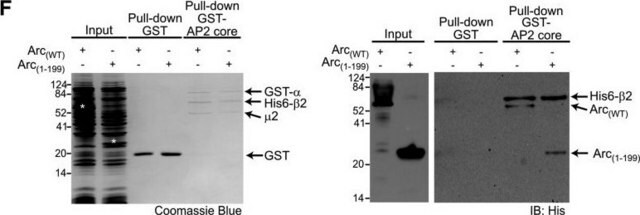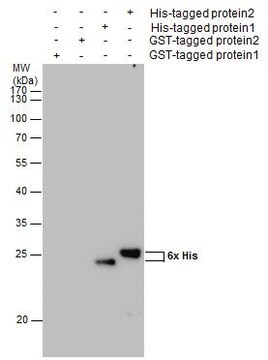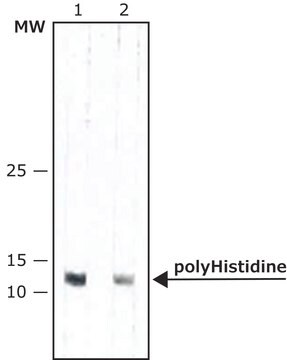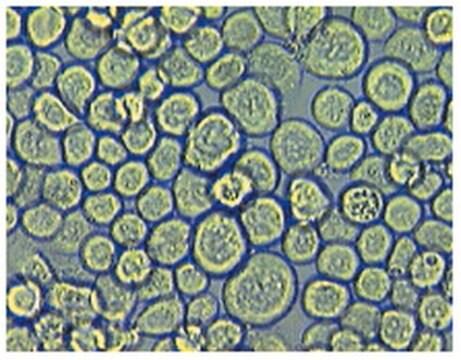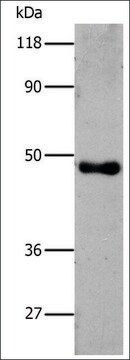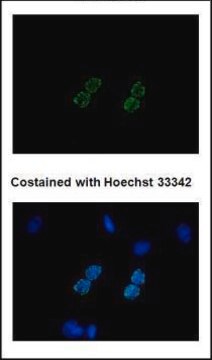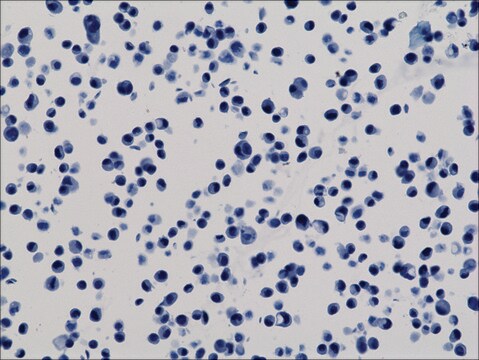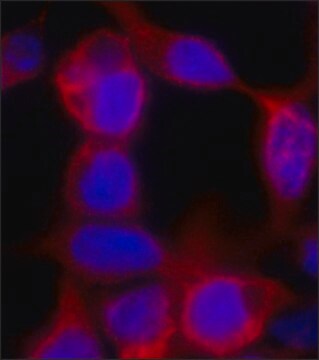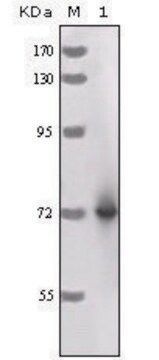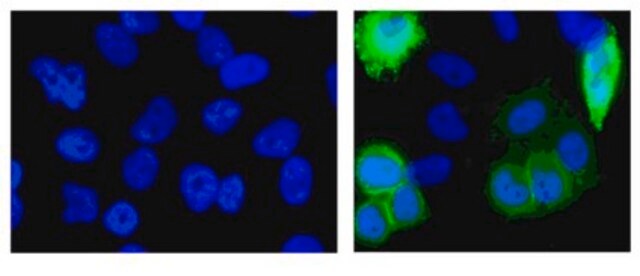11965085001
Roche
Anti-His6-Peroxidase
from mouse IgG1
Synonyme(s) :
antibody
Se connecterpour consulter vos tarifs contractuels et ceux de votre entreprise/organisme
About This Item
Code UNSPSC :
12352203
Produits recommandés
Source biologique
mouse
Niveau de qualité
Conjugué
peroxidase conjugate
Forme d'anticorps
purified immunoglobulin
Type de produit anticorps
primary antibodies
Clone
BMG-his-1, monoclonal
Forme
lyophilized
Conditionnement
pkg of 50 U
Fabricant/nom de marque
Roche
Isotype
IgG1
Température de stockage
2-8°C
Description générale
Anti-His6-Peroxidase is a monoclonal antibody to His6-tagged proteins, conjugated to horseradish peroxidase. Anti-His6-Peroxidase specifically recognizes an epitope of six consecutive histidine residues of both natural and recombinant proteins. The antibody reacts with native and denatured histidine-tagged fusion proteins independent of the epitope-sequence location; however, it preferentially recognizes the C-terminal His6 epitope with high sensitivity.
Spécificité
Anti-His6-Peroxidase specifically recognizes an epitope of six consecutive histidine residues (His6) in natural and recombinant proteins. It reacts with both native and denatured histidine-tagged fusion proteins, independent of location of the epitopesequence. However, Anti-His6-Peroxidase preferentially recognizes the C-terminal His6 epitope with high sensitivity. Anti-His6 allows specific and sensitive detection of histidine-tagged proteins irrespective of the expression system used.
The antibody recognizes an epitope of six consecutive histidine residues (His6) in natural and recombinant proteins. It reacts with both native and denatured histidine-tagged fusion proteins, independent of the epitope-sequence location.
Application
Anti-His6-Peroxidase has been used in in vitro serum stability of fusion toxins, pull-down assay and western blotting.
Anti-His6-Peroxidase is used for the detection of His6-tagged proteins in:
- ELISA (enzyme-linked immunosorbent assay)
- Western blot
Qualité
Function test: Western blot using extracts from cell line expressing a recombinant His6-tagged protein.
Notes préparatoires
Working concentration: Working concentration of conjugate depends on application and substrate.
The following concentrations should be taken as a guideline:
The following concentrations should be taken as a guideline:
- ELISA: 100 mU/ml
- Western blot: 100mU/ml
Reconstitution
Add 1 ml double-distilled water to a final concentration of 50 U/ml.
Reconstitution should be performed for at least 10 minutes.
Reconstitution should be performed for at least 10 minutes.
Autres remarques
For life science research only. Not for use in diagnostic procedures.
Vous ne trouvez pas le bon produit ?
Essayez notre Outil de sélection de produits.
Mention d'avertissement
Warning
Mentions de danger
Conseils de prudence
Classification des risques
Skin Sens. 1
Code de la classe de stockage
11 - Combustible Solids
Classe de danger pour l'eau (WGK)
WGK 1
Point d'éclair (°F)
does not flash
Point d'éclair (°C)
does not flash
Faites votre choix parmi les versions les plus récentes :
Déjà en possession de ce produit ?
Retrouvez la documentation relative aux produits que vous avez récemment achetés dans la Bibliothèque de documents.
Les clients ont également consulté
KaiC intersubunit communication facilitates robustness of circadian rhythms in cyanobacteria
Kitayama Y, et al.
Nature Communications, 4 (2013)
Two missense mutations in KCNQ1 cause pituitary hormone deficiency and maternally inherited gingival fibromatosis
Tommiska J, et al.
Nature Communications, 8(1) (2017)
Identification and Characterization of Heptaprenylglyceryl Phosphate Processing Enzymes in Bacillus subtilis
Linde M, et al.
The Journal of Biological Chemistry, 291(28), 14861-14870 (2016)
Manuel Simon et al.
Molecular cancer therapeutics, 13(2), 375-385 (2013-11-05)
Fusion toxins used for cancer-related therapy have demonstrated short circulation half-lives, which impairs tumor localization and, hence, efficacy. Here, we demonstrate that the pharmacokinetics of a fusion toxin composed of a designed ankyrin repeat protein (DARPin) and domain I-truncated Pseudomonas
Nick S Berrow et al.
Nucleic acids research, 35(6), e45-e45 (2007-02-24)
This article describes the construction of a set of versatile expression vectors based on the In-Fusion cloning enzyme and their use for high-throughput cloning and expression screening. Modifications to commonly used vectors rendering them compatible with In-Fusion has produced a
Notre équipe de scientifiques dispose d'une expérience dans tous les secteurs de la recherche, notamment en sciences de la vie, science des matériaux, synthèse chimique, chromatographie, analyse et dans de nombreux autres domaines..
Contacter notre Service technique
